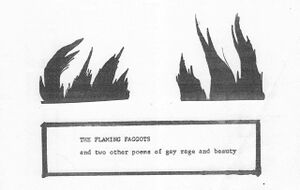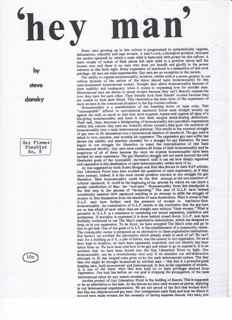The Effeminists
This page focuses on The Effeminists, a group of antisexist men formed in 1972 by former members of the Gay Liberation Front.
As Gay Liberation Front women began to refocus their energies on lesbian feminist activism in the spring and summer of 1970, a number of men followed their lead, forming living collectives and Consciousness-Raising groups to challenge male privilege, free themselves from the boundaries of conventional sex roles, and learn to “interact naturally” with each other.[1] One of the more controversial groups to develop out of this movement was the effeminists. Founded in New York City by Steven Dansky, John Knoebel, and Kenneth Pitchford—the husband of radical feminist Robin Morgan—the effeminists aligned themselves with the women’s liberation movement, eventually separating themselves from "Gay Liberation & all other Male Ideologies."[2]
The group maintained that sexism was at the root of all forms of oppression, arguing that only with women's rise to power could they create a just and equitable world. Operating under the radical premise that "all women are oppressed by all men," the effeminists rejected masculinity and challenged the "misogyny and effemiphobia" they saw in themselves and others.[3] They committed themselves to taking on an equal share of "the day-to-day life-sustaining drudgery that is usually consigned to women alone" and especially devoted themselves to "raising and caring for children."[4]
Just as important, the effeminists highlighted the discrimination faced by effeminate men, arguing that they too had "a stake in the destruction of the patriarchy." In the 1973 "Effeminist Manifesto," they called on "all such men as ourselves (whether celibate, homosexual, or heterosexual) to become traitors to the class of men...so that collectively we can struggle to change ourselves...into anti-masculinists and begin attacking those aspects of the patriarchal system that most directly oppress us."[5] What's more, they urged men to abandon conventionally masculine ways of thinking and acting, encouraging them to embrace traits like cooperation, tenderness, and egalitarianism.[6]

The effeminists saw homosexuality as an "affront to conventional manhood" and a move away from oppressive "male roles," but they also condemned the gay male subculture. They argued not only that gay men maintained some male privilege, but also that they directly participated in the oppression of women and perpetuated restrictive sex roles that "keep us in our oppression."[7] They were especially critical of camp (which they saw as "anti-woman mimicry and self-mimicry"); sado-masochism, sexual role playing, and cruising (which they viewed as objectifying); and transvestism (which they believed degraded women).[8]
More than just derisive of gay male culture generally, the effeminists also used their publication, Double F: A Magazine of Effeminism, to name individual men as “enemies of feminism,” a strategy that alienated many from the group.[9]
The effeminists sparked controversy among gay liberationists and feminists alike. Yet while they may have “seem[ed] ‘adventurist,’ violence prone and opaque” to some, others lauded them as "...the first western male revolutionaries. The first men to confess the inappropriateness of their manhood and to withdraw from the classic male demand of support from the female."[10]
The effeminists never grew far beyond their initial three members.[11] Still, the group played an important role in exposing the ways gay men retained male privilege and perpetuated male dominance while challenging all men to become involved in the movement for gender equity.
Kenneth Pitchford talks about his experiences as an effeminist:
<youtube>sIV-94dR9xM</youtube>
Return to Gay Liberation in New York City
References
- ↑ Toby Marotta, The Politics of Homosexuality (Boston, MA: Houghton Mifflin Company, 1981), 120
- ↑ Steven Dansky, John Knoebel, Kenneth Pitchford, "The Effemenist Manifesto," in We Are Everywhere: A Historical Sourcebook in Gay and Lesbian Politics, Mark Blasius and Shane Phelan, eds. (New York: Routledge, 1997), 435. The effeminists took their name, and some of their theories, from Nick Benton and Jim Rankin, who developed the term in 1971 in their Berkeley-based The Effeminist newspaper. Steven F. Dansky, “The Effeminist Moment,” in Smash the Church, Smash the State, ed. Tommi Avicolli Mecca (San Francisco: City Lights Books, 2009), 213-4.
- ↑ Dansky, Knoebel, Pitchford, "The Effeminist Manifesto," 435 and 438.
- ↑ Ibid., 438; Kenneth Pitchford, personal interview, January 28th, 2010
- ↑ Dansky, Knoebel, Pitchford, "The Effemenist Manifesto," 436.
- ↑ Dansky, Knoebel, Pitchford, "The Effemenist Manifesto," 437; Kenneth Pitchford, email correspondence, March 5, 2010.
- ↑ Steve Dansky, "Hey Man," Gay Flames Pamphlet, no. 8. Gay Liberation Front (GLF) N.Y. Organizational File, Lesbian Herstory Archives, Brooklyn, NY
- ↑ Dansky, Knoebel, Pitchford, "The Effemenist Manifesto," 436-7.
- ↑ Karla Jay, Tales of a Lavender Menace (New York: Basic Books, 2000), 235; Dansky, “The Effeminist Moment,” 213.
- ↑ Martin Duberman, "Homosexual Literature," The New York Times, December 10, 1972, 28; jill johnston, quoted in Dansky, "The Effeminist Moment," 214.
- ↑ Ibid., 213
